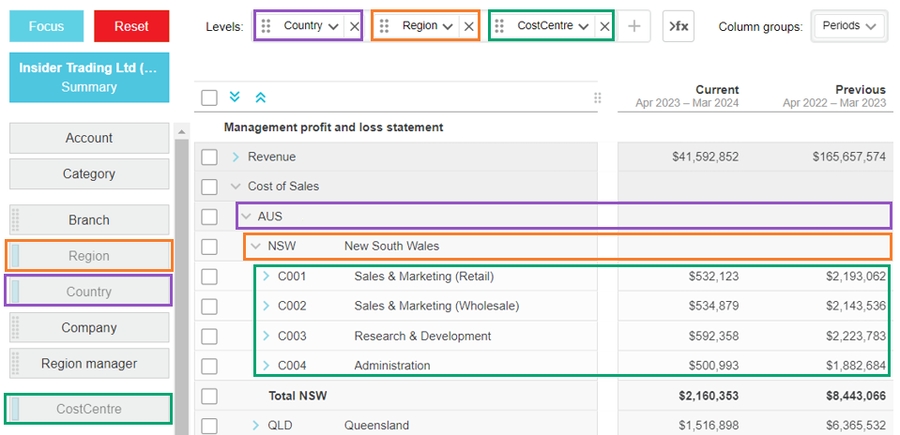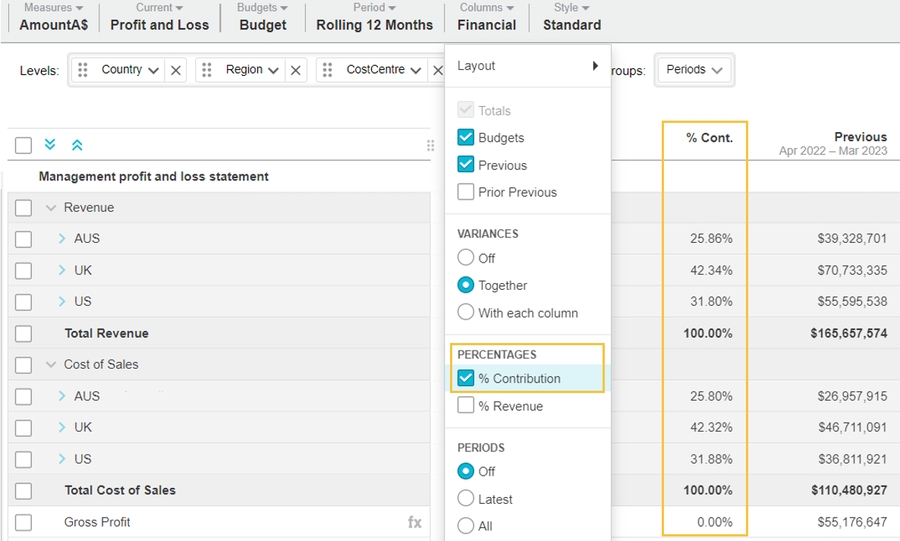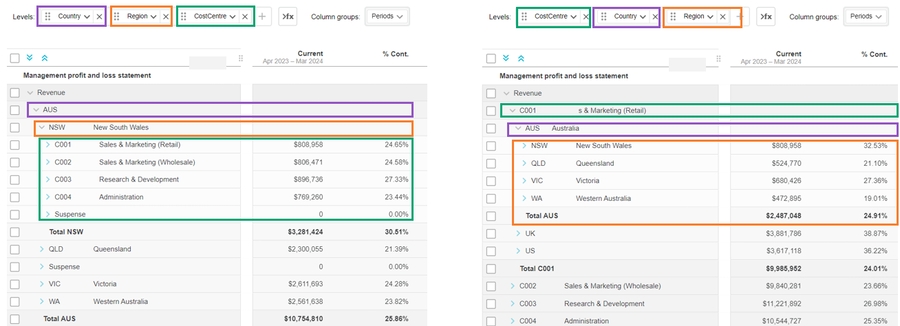Add a level in a financial statement
Add up to four dimensions as levels in a financial statement to create a nested view of the information and enable vertical analysis. The levels make the information easier to interpret, allowing you to see the contribution of individual items to overall performance.
Details for all the entities in the dimension are displayed as additional rows in the grid. However, the values in the total rows, such as gross profit, remain at the summary level.
Watch these PUG Training videos: Financial Statements 101 (jump to 17:03) and Financial Statements – Advanced (jump to 03:29)
Add a level
Use one of these methods to add a level via the Levels dropzone above the grid:
Click and drag a dimension into the dropzone.
Click the blue Add button next to the dropzone and select the required dimension.
For example, suppose your organization operates in three countries, and you want to view the contribution each country is making towards the overall revenue value. You add the Country dimension as a level, then expand the Revenue row to view the revenue broken down by country.

Repeat the above step to add more levels.
To view the additional levels of detail, either click the Expand All button on the top-left of the grid or click the Expand button on a specific row.
Change the order of levels
The Category and Account levels are fixed, but you can change the order of the dimensions that sit in the levels between them. The order in which the dimensions appear in the Levels dropzone determines how they are displayed in the statement.
To reorder the levels, click the Move button on a dimension in the Levels dropzone, then drag the dimension to the left or right of the other dimension(s) in the dropzone.
Filter levels
When you add a level to a financial statement, a row is added for each entity in that dimension. If you are only interested in one or some entities, filter the level to remove the surplus entity rows from the statement. Filter multiple levels to further refine the data.
Filter one level
In the Levels dropzone, click the dropdown button in the dimension. You get a list of all the entities in that dimension.
Select the checkboxes of the entities you want to see in the financial statement. Find the entities by either browsing the list or using the search box at the top, where you can:
Type in part of the name or code to filter the list and quickly find a specific entity. You can type multiple names or codes, separated by a semi-colon.
Paste a list of codes you copied from elsewhere, using a semi-colon as a separator.

Click out of the entity list to apply the filter.
The number of selected entities is displayed on the dimension button on the left of the grid and the dimension in the Levels dropzone.
A filter chip displays on the right, so it's easy for you to keep track of what you are filtering.
Expand the applicable level in the grid to see the filter results. Only the rows for your selected entities are displayed.
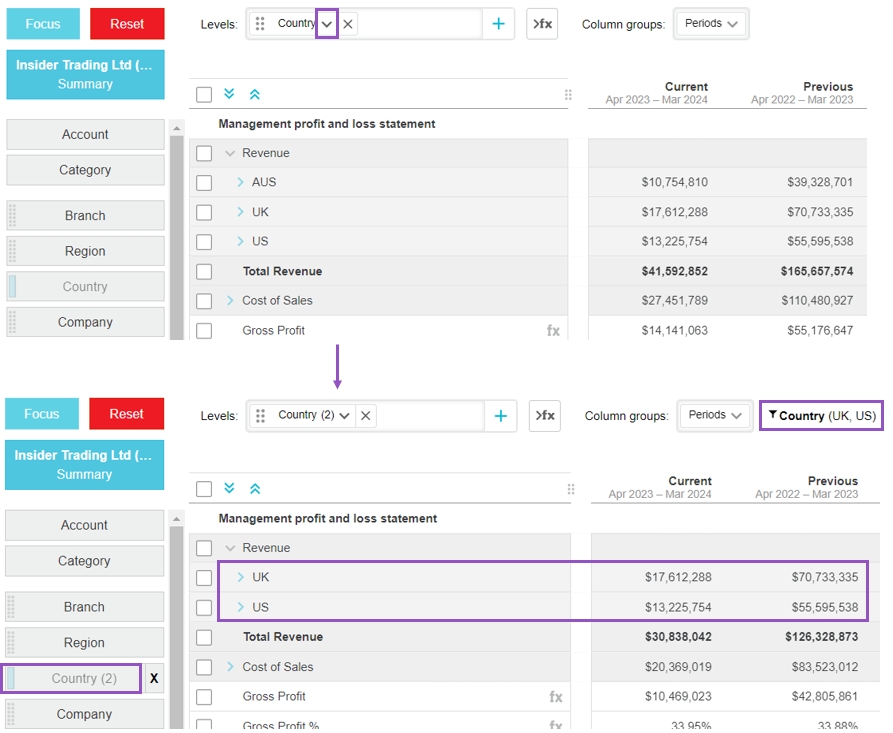
After applying a filter, if you reopen that level filter, the entity list now shows only the selected items (in other words, only the items that have activity in the statement).

Filter multiple levels
When you apply a filter to one level, any subsequent level you open shows only the items that are present in the statement, according to the existing filter.
For example, if you apply a filter to the Trading Entity level selecting only one item, then open the Department level filter, you’ll only see departments that belong to that selected trading entity. This helps you focus on relevant items and reduces noise when working across multiple levels.
Select the other items you want to include in the filter, then click out of the list to refresh the statement.

Remove filters
There are several ways to change a filter or return to the high-level summary financial information:
With the dimension dropdown list open, use one of these methods:
Use the new Show all option next to the search box to view all items in the level. You can then select or deselect the items as required.
Click Select none to return to the full list of unselected items.
Click the X on the dimension button(s) in the dimension panel.
Click the X on the filter chip.
Use the Rows (activity filter) menu in the toolbar.
Expand calculation levels
When you add a level to a financial statement, by default, the calculation rows are not expandable; you can only expand the category (group) rows. You have the option to expand the calculation rows, to view the contribution of each item (entity) to the calculation total. For example, you might want to view a quick breakdown of the Gross Profit by Country.
Click the Calculation button next to the Levels dropzone to allow the calculation rows to be expanded. This button is a switch, so you can turn the feature on and off as required. Expand the calculation rows as required.
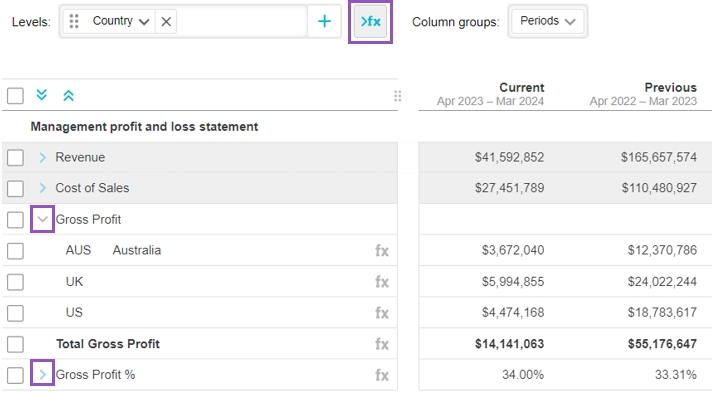
Remove a level
To remove a level from the grid, either click the X button on the dimension in the Levels dropzone or drag it out of the dropzone.

You can also drag a dimension from the Levels dropzone into the Column groups dropzone to transform the grid into a matrix format.
Last updated

